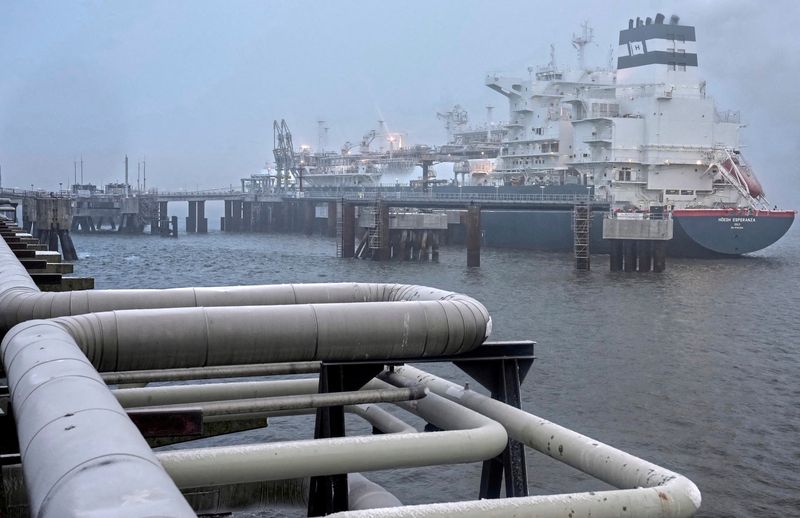(Adds EU plan for new gas benchmark price, detail on original Commission proposal)
By Susanna Twidale, Kate Abnett and Gabriela Baczynska
(Reuters) - European Union countries agreed on Monday to cap gas prices, after debating for months whether the measure could hinder rather than help Europe's efforts to cope with an energy crisis.
The aim is to shield European households and businesses from the kind of gas price spikes experienced since Russia's invasion of Ukraine. High energy prices in Europe have fuelled the highest inflation in decades.
But the idea divided the EU's 27 member countries as some, including Europe's biggest economy and biggest gas user Germany, feared it could make sourcing supplies more difficult on competitive world markets.
Energy ministers on Monday agreed a compromise proposal that would mean a price cap is triggered if prices exceed 180 euros per megawatt hour for three days on the Dutch Title Transfer Facility (TTF) gas hub's front-month contract, which serves as the European benchmark.
Here's what you need to know.
WHY CAP GAS PRICES?
Russia has reduced gas deliveries to Europe following its February invasion of Ukraine. To try to limit the impact of the resulting high prices, around 15 EU countries including Belgium, Italy, Greece and Poland had called for a Europe-wide gas price cap.
Gas prices have eased in recent months as the EU agreed some emergency measures, including obligations to fill gas storage, but they remain high.
The front-month contract on the Dutch Title Transfer Facility (TTF) gas hub was trading around 107 euros per megawatt hour (MWh) on Monday.
That compares with 95 euros/MWh a year ago and 14.20 euros/MWh two years ago.
HOW WOULD THE EU CAP WORK?
Under the plan agreed on Monday, the cap can be triggered starting from Feb. 15 2023 if prices exceed 180 euros per megawatt hour for three days.
To trigger the cap, the front-month TTF contract must also be 35 eur/MWh higher than a reference price based on existing liquefied natural gas (LNG) price assessments for three days.
Once triggered, the cap would prevent trades being done on the front-month, three-month and front-year TTF contracts at a price more than 35 eur/MWh above the reference LNG price. This effectively caps the price at which gas can be traded.
The EU price cap would not drop below 180 eur/MWh, even if the LNG price fell to far lower levels. But if the LNG reference price increased to higher levels, then the EU cap would move with it, while remaining 35 eur/MWh above the LNG price - a system designed to ensure the bloc can bid above market prices to attract scarce fuel.
Once triggered, the price cap will apply for at least 20 working days. It can then be deactivated if prices fall below 180 eur/MWh for three days.
The cap will apply to all virtual gas trading platforms in the EU. Initially at least it will not affect private gas trades outside energy exchanges, which the Commission has said were a safety valve for critical deliveries and were unlikely to take over any major share of trade.
WHAT DO EU COUNTRIES THINK?
EU countries have long been divided over whether to cap prices.
An original Commission proposal last month, to trigger a cap if prices hit 275 eur/MWh, was widely criticised by countries. That proposal included conditions so strict that even a record-breaking surge in European gas prices to above 340 eur/MWh in August would not have triggered it.
Meanwhile, Germany, as well as the Netherlands and Austria, have resisted any cap, fearing it would disrupt the functioning of Europe's energy market and divert gas cargoes to regions where prices are higher.
Germany eventually approved the price cap after Berlin won tougher rules to suspend the policy if it has unintended consequences, and changes to another EU law on renewable energy permits, an EU official told Reuters.
The Netherlands and Austria abstained. Hungary was the only EU country to oppose the measure, EU officials said.
The safeguards won by sceptical countries include that the cap will be suspended if the EU faces a gas supply shortage, or if the cap causes a drop in TTF trading, a jump in gas use or a significant increase in gas market participants' margin calls.
The European Commission may also suspend the cap if an analysis by EU regulators, due by Mar. 2023, finds the policy's risks outweigh its benefits, EU energy commissioner Kadri Simson said.
WHAT DO GAS MARKET PARTICIPANTS THINK?
Market actors including the Intercontinental Exchange (NYSE:ICE), which hosts gas TTF trading, have warned the Commission not to go ahead with its proposal.
In a memo sent to the Commission, seen by Reuters, ICE said the proposal could cause liquidity providers to stop selling TTF gas futures, which would drive prices higher.
The Association of European Energy Exchanges has said the EU plan could pose a major risk to financial stability in Europe's energy markets, and cause utilities to move to more risky private trading to avoid the cap.
The EU price cap is designed to be a temporary fix that would apply for one year.
As a longer-term solution, the Commission wants to form a new LNG price benchmark in Europe since the TTF price is largely guided by pipeline gas supplies. Brussels has asked EU energy regulators to launch one by the end of March.
($1 = 0.9522 euros)
